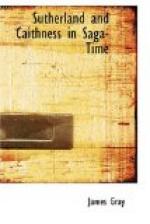Robertson’s explanation is that Malcolm was Earl of Caithness only as guardian of a ward entitled to that earldom. The question then arises, as Robertson puts it, “who was the heir?” and he answers it, “certainly not his[8] uncle Magnus, son of Gillebride,[9] but very probably the son of Magnus by Earl John’s daughter; the supposed grant of the Earldom to this Magnus being probably grounded upon his real marriage with the heiress,” and he adds “If, on the death of Earl John in 1231, his grandson was an orphan and a minor, his wardship would naturally have been granted to the next of kin, his cousin the Earl of Angus.”
One further charter has to be dealt with. In Reg. Hon. de Morton, vol. I, p. xxxv, cited in Origines Parochiales vol. II, p. 805, a grant by King Alexander II, to Patrick Earl of Dunbar dated 7th July 1235 is attested by a witness, whose name or initial is illegible, but who is styled ... Earl ... Katanay, ... Comite ... Katanay, and a confident opinion is expressed in a note to the citation that the witness was Magnus, Earl of Caithness. Now, Earl John’s daughter was taken as a hostage on August 1, 1214, and, if she was then marriageable and was married at once, her eldest child could have been born about May 1215, and would attain twenty-one about May 1236, but to suppose her son of the name of Magnus to have been the ward for whom the Earldom of Caithness was being kept till 7th July 1235 from 1232 and that he had become Earl of Caithness on the 7th July 1235 seems impossible. If the blank should be filled up with “de Anegus et,” then Malcolm Earl of Angus must still have been the guardian, and the ward’s father and mother must both have been dead by 7th October 1232. This involves three unproved assumptions, of two unrecorded deaths and one unrecorded birth.
On the whole, therefore, we believe that there is another and simpler explanation, and it seems probable that there was in this case no wardship, or if there was, that there was a great deal more, and that Malcolm held the earldom of Caithness as Custos or administrator or trustee for the Crown for four years after Earl John’s death till the succession was settled, and till all Caithness except Sutherland was parcelled out among three claimants, namely the two heirs, each of one of two sisters of Harald Ungi, and the hostage daughter of Earl John.
When all this was settled, Magnus, as the son of one of the two elder sisters of Harald Ungi, and also as the husband of Earl John’s daughter, would be entitled on Earl John’s death, jure maritae, in Orkney, to a grant from the Norse king of the Orkney jarldom, and also, in Caithness, first, jure maritae, to a grant from the Scottish king in or after 3rd July 1236, of the North Caithness earldom and lands held by Earl John, which Dalrymple in his Collections (p. lxxiii) states positively, without quoting his authority, that Magnus had for a payment of L10 per annum, and, secondly, jure matris (Ingibiorg or Elin) to a grant, also from the Scottish king, of the earldom of South Caithness, which by the Charter of Alexander “under the greit Seill,” above alluded to, Magnus also got.




